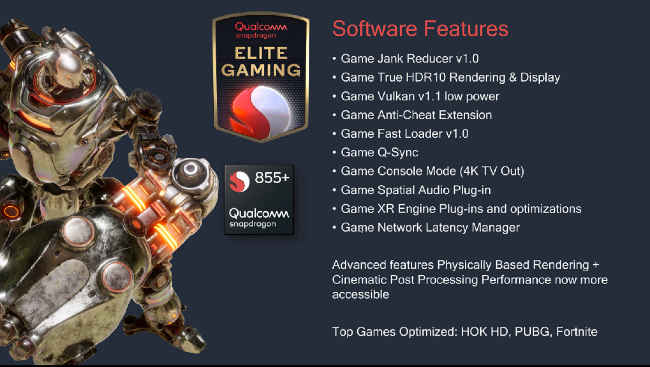In a bid to set gaming smartphones apart, Qualcomm announced the Snapdragon 855 Plus chipset targeted at the flagship gaming smartphones. The major upgrade in the Plus variant is in the GPU and CPU. The GPU is now 15 percent faster while the CPU can now go up to 2.96GHz as compared to the 2.84GHz limit on the regular Snapdragon 855. To be honest, Qualcomm has been pushing the frontier of mobile gaming ever since it announced the Snapdragon 855 last year in December. Back then, Qualcomm unveiled what it calls Elite Gaming, which is basically a suite of features that enhance the experience of gaming on your smartphone.
Snapdragon 855 Plus vs Snapdragon 855: What’s the difference?The primary difference between the Snapdragon 855 Plus and the Snapdragon 855 is in the CPU and GPU. Like the Snapdragon 855, the Snapdragon 855 also has a tri-cluster CPU arrangement, with one Kryo 485 Prime core, three mid-cores and four efficiency cores. Only, the single Kryo 485 Prime core is clocked at 2.96GHz instead of 2.84GHz. The higher clock-speed essentially brings the flagship chipset closer to the speeds promised by ARM for the Cortex-A76, on which the Kryo 485 is based. However, considering the architecture is the same in both the chipsets, we’re not sure whether there will thermal bottlenecks when running at peak clock speeds. Next, the Adreno 640 GPU on the Snapdragon 855 Plus is 15 percent faster than the one on the regular Snapdragon 855.
Apart from this, the rest of the components in the SoC are the same. The Snapdragon 855 brings a dedicated Computer-Vision accelerator in the ISP along with the fastest 4G modem for mobile, as well as support for a 5G chip. There’s also dedicated Tensor and Vector accelerators in the DSP which aids in customised AI tasks and supports the most cutting edge hardware available for mobile at present. Clearly, the Snapdragon 855 is every bit a flagship, so why then Qualcomm felt the need to make an enhanced version of it?
Why another flagship chipset?It’s very unlike Qualcomm to release yet another flagship SoC in the same year. However, it can be argued that the Snapdragon 855+ is just an enhanced version of the 855 and not a replacement or an upgrade. Qualcomm saw an opportunity in the budding mobile gaming market and tried to make the best of it. Hot on the heels, MediaTek also announced it’s a gamer-centric SoC as well called the Helio G90, while Huawei is yet to show up with their version of it. It’s also noteworthy that each and every smartphone that markets itself for their gaming capabilities sport the Snapdragon 855. But so does most other high-end and premium flagship. And as such, save for extra helpings of RAM and a bunch of accessories, there wasn’t really a difference in the gaming experience between the regular flagships and the gaming ones. The Snapdragon 855+ was announced to help address this growing need to differentiate. The boost in CPU and GPU is one way of doing it. However, Qualcomm also unveiled some new Elite Gaming features. What is Elite Gaming, you may ask?
What’s Elite Gaming?
The Snapdragon Elite Gaming term first came up at the Snapdragon Annual Summit last year in Hawaii. It’s basically an umbrella term for a set of optimisations that Qualcomm offers to game developers to make the experience of gaming on the Snapdragon-powered smartphone richer. As such, it includes optimisations in frame rate stability, high-quality surround sound, network optimisations and more.
The Snapdragon 855+ adds to this set of features. Thanks to a faster CPU and GPU, the SoC is able to do much more. There’s HDR10 rendering support during gaming. Smartphones with HDR10 displays can leverage HDR-quality visuals while gaming which gives a much better and realistic experience. Jank Reducer which makes gameplay smoother by taking care of 90 percent janks in a 30FPS game with the visual settings intact. This is in fact similar to what Huawei does in the GPU Turbo feature, but Qualcomm claims no loss in visual quality. The SoC is able to support Vulkan 1.1 API for low-level graphics. It’s much more efficient than OpenGL-based graphics and can be considered a step towards unifying mobile platforms with consoles and PCs. Then there’s Q-Sync which matches the display refresh rate with the game’s frame rates to prevent screen-tearing or stuttering. It’s similar to Nvidia’s G-Sync or AMD’s FreeSync feature. A Snapdragon 855+ powered smartphone is also ready to become an XR-device and is 5G ready. Elite Gaming also includes Physcially-based rendering and cinematic post-processing, terms that game developers use to mean realistic rendering of visual effects. The demo showed a marked improvement in the quality of graphics including more detailed reflections and textures.
What’s the catch?Elite Gaming certainly sounds, elite. Anyone reading the set of features might feel mobile gaming is now at par with the consoles and PCs. But that’s far from the truth. The truth is, only a handful of games presently support these features. They include PUBG Mobile, Honor of Kings, and Fortnite, at least as advertised by Qualcomm. Other titles either don’t support or don’t state their support explicitly. There’s also the question of exclusivity. Qualcomm said the new Elite Gaming features will also be supported by the regular Snapdragon 855 which again muddies the ground between the regular flagships and the gaming flagships. Not that that’s a bad thing for the end user. It’s also worth noting that while Qualcomm is enabling support for next-gen gaming, it’s upto the OEMs to use them and more importantly, for game developers to implement them. Unless all three come together, mobile gaming will not breach the next frontier.
from Latest Technology News https://ift.tt/2YjMHk9

No comments:
Post a Comment